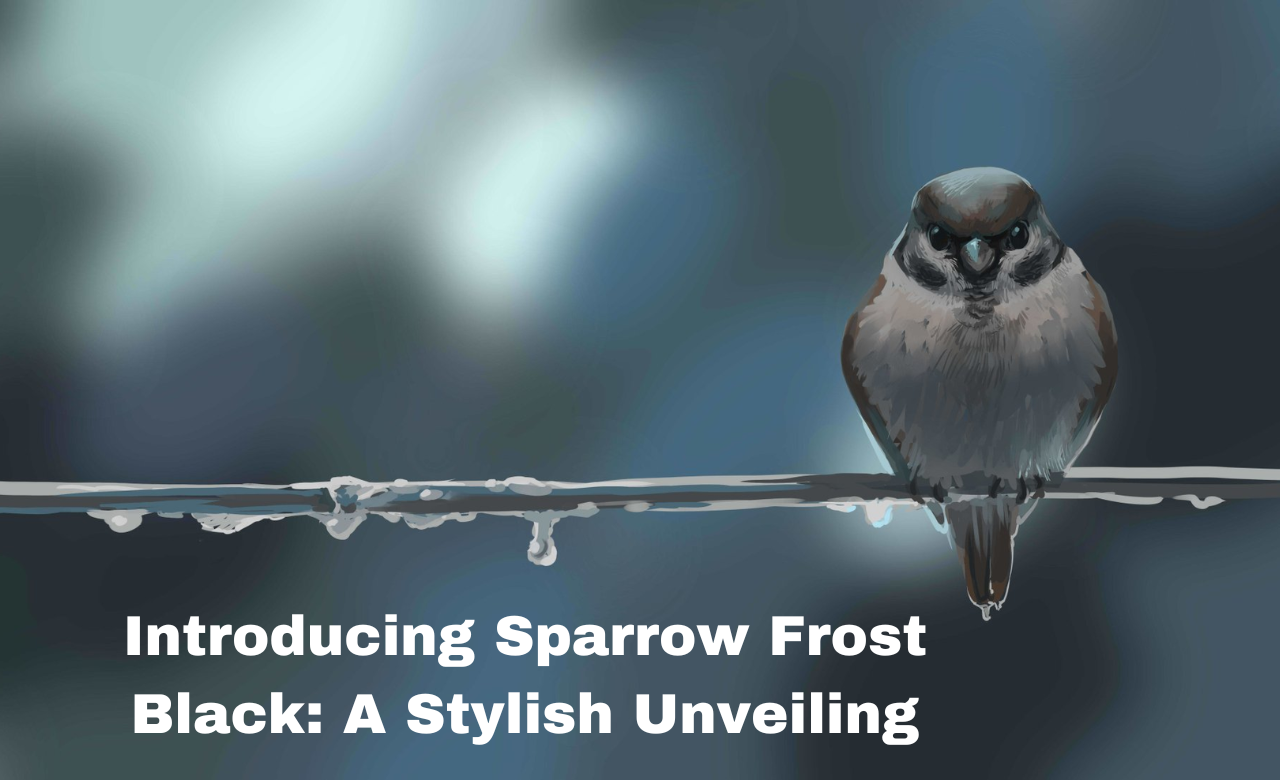Sparrow Frost Black is also called Passerella iliaca. It is a type of bird in the Emberizidae family. You can spot them in many different places in North America, from the top of Canada to the bottom of Mexico.
Contents
- 1 Exploring The Origins Of Sparrow Frost Black
- 2 Sparrow Frost Black’s Scientific Name
- 3 Understanding The Science Of Sparrow Frost Black
- 4 The Decline And Sorrowful Stare
- 5 A Little Shape On The Snow
- 6 Whispers f Winter
- 7 Elara, The Guardian Of Mysteries
- 8 Understanding Sparrow Frost Black Characteristics
- 9 Physical Characteristics
- 10 Frequently Ask Question
- 11 Conclusion
Exploring The Origins Of Sparrow Frost Black
Let’s delve into the story of where Sparrow Frost Black comes from. This little bird with dark feathers has a fascinating history.
It’s believed that Sparrow Frost Black evolved in North America, adapting to survive in cold climates.
Over time, its feathers developed a unique shade, resembling the night sky with a touch of frost. These birds are often found in regions where winter is harsh, like Canada and parts of the United States.
Despite their small size, Sparrow Frost Blacks are resilient creatures, braving the cold winters with their elegant movements and distinctive appearance.
Sparrow Frost Black’s Scientific Name
Let’s talk about the fancy name of Sparrow Frost Black. Scientists call it “Passerella iliaca.” It might sound complex, but it’s just their way of giving each bird species a name.
This particular name helps scientists worldwide understand which bird they’re talking about.
So, whenever you hear “Passerella iliaca,” you’ll know they’re talking about our stylish Sparrow Frost Black!
Understanding The Science Of Sparrow Frost Black
Understanding the Science of Sparrow Frost Black means learning about these unique birds and how they’re studied.
Scientists use names like Passer domesticus (House Sparrow) or Passer montanus (Tree Sparrow) to discuss them.
These birds have fabulous black feathers with frosty edges, which makes them stand out. People who love birds and scientists want to learn more about Sparrow Frost Black.
The Decline And Sorrowful Stare
In the battle, many were hurt. Sparrow saw how hard it was to keep going, mainly because of the Frost Black legacy. The journey was full of betrayals and sacrifices, and Sparrow felt the sadness that came with it.
As Sparrow thought about their journey, they wondered what it all meant. Were they too proud or courageous?
Did their name protect them or predict their end? Even though it seemed like the end of their story was already written, Sparrow’s fate wasn’t sure yet.
A Little Shape On The Snow
The sparrow frost black stood out from the others. His feathers looked like the night sky with frost, while the rest had brown feathers.
He moved around like a dark shadow on the snowy ground, seeming different from the others. With their sunny-colored feathers, the other sparrows stayed away from him and whispered about him, making him feel cold.
Whispers f Winter
Sparrow Frost Black noticed how the other birds felt uneasy around him. He stood out in their familiar world, sparking their curiosity.
But he couldn’t afford to be afraid.
Winter demanded constant vigilance, its cold creeping into every part of his life. His days were filled with searching for frozen scraps and perching on icy branches.
With the elegance of a dancer, Sparrow Frost Black gracefully moved through the landscape. He hopped from branch to snow-covered ground, his dark feathers almost disappearing in the barren surroundings.
Despite the chill and isolation, he persevered, was resilient, and determined to survive the harsh winter.
Elara, The Guardian Of Mysteries
One day, Sparrow saw an old, empty millhouse. A bit of smoke came from its chimney, giving him a little hope.
Feeling curious, Sparrow went closer and knocked on the door. A kind old lady opened it and didn’t seem scared like others. Instead, she seemed to understand Sparrow despite her hands being different.
The lady said gently, “Her name is Elara; she knows the secrets of winter.” Sparrow spent some time with Elara and learned ancient stories and wisdom.
Elara didn’t see Sparrow as scary; she saw him as someone who could share winter stories.
Understanding Sparrow Frost Black Characteristics
- Appearance
- Habitat
- Behavior
- Resilience
- Survival Skills
- Adaptations
Appearance
Sparrow Frost Black stands out because of how it looks. Its feathers are dark and shiny, like the sky at night. And if you look closely, you might see a hint of frost on them, making them even more unique.
In simple words, Sparrow Frost Black looks special because its feathers are dark like the night sky and sometimes have a slight frost on them.
Habitat
Sparrow Frost Blackbirds like to live in North America, especially where it gets freezing, like Canada and some parts of the United States. They feel at home in these chilly places, making them quite common.
In simpler terms, Sparrow Frost Blackbirds live in North America, especially where it’s freezing, like Canada and parts of the United States.
Behavior
Sparrow Frost Black moves around gracefully. You might see it hopping from place to place or sitting on branches. It’s good at blending in with the snow, sometimes making it hard to spot.
In simpler words, Sparrow Frost Black moves gracefully, hopping around or sitting on branches. It’s so good at hiding in the snow that you might not even notice it!
Resilience
Even when winter gets tough, Sparrow Frost Black doesn’t give up. It’s good at adjusting to the cold weather and finding ways to live well in its habitat.
In simpler words, Sparrow Frost Black doesn’t let the cold winter bother it. It’s good at adapting and living happily in its home, even when the weather is harsh.
Survival Skills
Sparrow Frost Black is resourceful when finding food, especially during cold winter. Even when everything seems frozen, it manages to scavenge for bits of food that are frozen or hidden away. Additionally, it cleverly uses icy branches to rest and perch on, making the most of its surroundings.
In simpler terms, Sparrow Frost Black is good at finding food, even when it’s cold outside. It can discover bits of frozen food and can sit on icy branches without slipping.
Adaptations
As time passed, Sparrow Frost Black changed to survive in cold places with harsh winters. These changes include both its body and the way it behaves.
In simpler terms, Sparrow Frost Black has adapted to living in cold places with harsh winters by changing its body and how it acts.
Physical Characteristics
- Coloration
- Size
- Shape
- Beak
- Eyes
- Feet
- Plumage
- Tail
- Overall Appearance
Coloration
Sparrow Frost Black has dark feathers, often black or dark brown.
Size
It is a small bird, typically measuring 6 to 7 inches long.
Shape
Sparrow Frost Black has a compact body with a rounded shape.
Beak
Its beak is small and pointed, suited for cracking seeds and insects.
Eyes
The eyes of Sparrow Frost Black are usually dark and small.
Feet
It has tiny, clawed feet adapted for perching on branches.
Plumage
Its feathers are dense and provide insulation against cold temperatures.
Tail
The tail of Sparrow Frost Black is relatively short and rounded.
Overall Appearance
Sparrow Frost Black’s physical characteristics help it blend into its environment, especially during snowy conditions.
Frequently Ask Question
Does Sparrow Frost Black pose a threat to other sparrows?
No, Sparrow Frost Black is not harmful to other sparrows.
What actions can I take to help protect sparrows and their habitats?
You can aid in conserving sparrows and their habitats by creating bird-friendly spaces, minimizing pesticide use, and supporting conservation initiatives.
Is it possible to have Sparrow Frost Blacks as pets?
No, Sparrow Frost Blacks are not typically kept as pets.
Do Sparrow Frost Blacks migrate in the winter season?
Yes, Sparrow Frost Blacks are known to migrate during the winter season.
Are Sparrow Frost Blacks at risk of extinction?
No, Sparrow Frost Blacks are not currently at risk of extinction.
Conclusion
To sum up, Sparrow Frost Black is an intriguing bird species with distinctive traits and ecological significance.
It’s crucial to comprehend their biology, behavior, and conservation requirements to safeguard their existence and maintain biodiversity in their natural environments.











